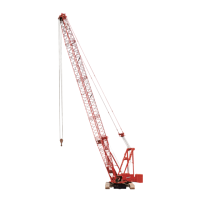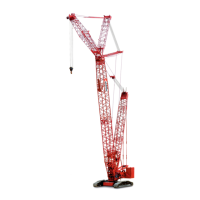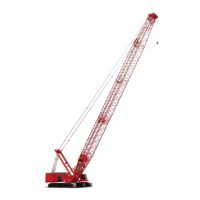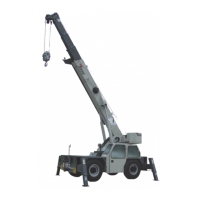Manitowoc Published 05-15-17, Control # 043-09 2-17
999 LUFFING JIB OPERATOR MANUAL SAFETY INFORMATION
The crane must not be returned to service until it is
thoroughly inspected for any evidence of damage. All
damaged parts must be repaired or replaced as authorized
by Manitowoc.
SAFE MAINTENANCE
Maintenance Instructions
To ensure safe and proper operation of Manitowoc cranes,
they must be maintained according to the instructions
contained in this manual and in the Service Manual provided
with the crane.
Crane maintenance and repair must be performed by
qualified personnel. These personnel shall read the
Operator Manual and Service Manual before attempting
any maintenance procedure. If there is any question
regarding maintenance procedures or specifications, contact
your Manitowoc dealer for assistance.
Qualified person is defined as one who by reason of
training and experience is thoroughly familiar with the
crane’s operation and required maintenance as well as the
hazards involved in performing these tasks.
Training and qualification of maintenance and repair
personnel are crane owner’s responsibility.
Safe Maintenance Practices
1. Perform the following steps (as applicable) before
starting a maintenance procedure:
a. Park the crane where it will not interfere with other
equipment or operations.
b. Lower all loads to the ground or otherwise secure
them against movement.
c. Lower the boom onto blocking at ground level, if
possible, or otherwise secure the boom against
dropping.
d. Move all controls to off and secure all functions
against movement by applying or engaging all
brakes, pawls, or other locking devices.
e. Stop the engine and render the starting means
inoperative.
f. Place a warning sign at the start controls alerting
other personnel that the crane is being serviced and
the engine must not be started. Do not remove
sign until it is safe to return crane to service.
2. Do not attempt to maintain or repair any part of the crane
while the engine is running, unless absolutely
necessary.
If the engine must be run, keep your clothing and all
parts of your body away from moving parts. Maintain
constant verbal communication between person at
controls and person performing maintenance or
repair procedure.
3. Wear clothing that is relatively tight and belted.
4. Wear appropriate eye protection and approved hard hat.
5. Never climb onto or off a moving crane. Climb onto and
off crane only when it is parked and only with
operator’s permission.
Use both hands and handrails, steps and ladders
provided to climb onto and off the crane.
Lift tools and other equipment which cannot be carried in
pockets or tool belts onto and off the crane with hand
lines or hoists.
6. The boom and gantry are not intended as ladders. Do
not attempt to climb lattice work of the boom or gantry to
get to maintenance points. If the boom or gantry is not
equipped with an approved ladder, lower them before
performing maintenance or repair procedures.
7. Do not remove cylinders until the working unit has been
securely restrained against movement.
8. Pinch points are impossible to eliminate. Watch for them
closely.
9. Pressurized air, coolant, and hydraulic oil can cause
serious injury. Make sure all air, coolant, and hydraulic
lines, fittings, and components are tight and serviceable.
Do not use your hands to check for air, coolant or
hydraulic oil leaks:
• Use a soap and water solution to check for air leaks
(apply to fittings and lines and watch for bubbles).
• Use a piece of cardboard or wood to check for
coolant and hydraulic oil leaks.
10. Relieve pressure before disconnecting air, coolant, and
hydraulic lines and fittings.
WARNING
Importance of safe maintenance cannot be over
emphasized. Carelessness and neglect on part of
maintenance personnel can result in their death or injury
and costly damage to the crane or property.
Safety information in this publication is intended only as a
guide to assist qualified maintenance personnel in safe
maintenance. Manitowoc cannot foresee all hazards that
will arise in the field. Therefore, safety remains
responsibility of maintenance personnel and crane
owner.
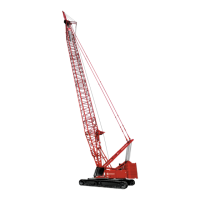
